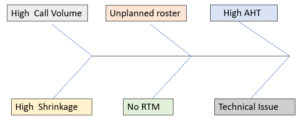5 Six Sigma Tools Used in Call Center
Six Sigma is one of the most common tools across industries to reduce variances, and errors and improve quality by systematically identifying and addressing defects. Especially in the customer service industry, the Call Center, role of the Six Sigma method has become more vital.

In today’s blog, we will explore 5 common yet effective Six Sigma Tools Used in Call Center. Before jumping to the tools usage let’s first understand “What is Six Sigma in Call Center ?”
What is Six Sigma in Call Center?
Six Sigma is a methodology that is used in call centers to improve customer service, reduce agent errors, and meet several call center metrics. Six Sigma works on DMAIC methodology Where D = Define, M = Measure, A =Analyze, I = Improvement, and C = Control.
With the help of the DMAIC method and certain Six Sigma tools, we can improve Customer satisfaction,
Read full blog : What is Six Sigma in Call Center
Now let’s discuss some common tools used in Call Center for process improvement and other metrics.
Let’s Start :
5 Six Sigma Tools Used in Call Center
Although Six Sigma has various tools to improve process but we will discuss 5 major Six Sigma tools used in Call Center :
1. PARETO Analysis :
One of the most common Six Sigma tools used in Call Center is PARETO Analysis , also known as 80/20 rule. This six sigma tool is primarily used in the call center to improve the process and call quality. In Pareto Analysis with the help of chart we figure out that 80 % impact to the process happens because of 20% controllable or uncontrollable errors.
In Short Pareto or 80/20 rule states that :
80% of the dent to process comes from 20% of causes in the process. If we focus on fixing these 20% defects we can enhance the overall health of process”
The most common use or PARETO Analysis in Call Center is to identify agent errors and improve the process quality scores.
Click here for the latest jobs :
Let’s move to the next tool use :
2. FISHBONE Diagram:
Fishbone diagram , also known as “Cause and Effect” or ” Ishikawa” Diagram , is an effective tool to identify and analyze root causes of a problem in Six Sigma technique. Fishbone as the name refers is a visual diagram where all the root causes of a problem are consolidate on the top of different lines , look like the bone of a fish.
Fishbone diagram is a good way to visually showcase the root causes of a problem, allowing truly diagnose the problem rather than focusing on symptoms.
Below is one visual “Cause and Effect” for ” High Abandon rate in Call Center ”

3. FMEA :
FMEA stands for Failure Mode and Effect Analysis . In Call Center, FMEA is a common tool to identify defects and improve the call quality or overall process quality. In Call Center, FMEA involves :
“Identifying potential failures, determining their impact on customer service, and prioritizing preventive measures.”
FMEA technique is a result of 5 steps , that are interlinked with each other. These are:
Step 1 : Determine the Problem
Step 2 : Create step by step guide to analyze the problem
Step 3 : Analyze Each Step and Determine Problem Areas. …
Step 4 : Select the most impacting issues to be prioritized.
Step 5 : Implement the Changes.
4. 5 WHYs :
5 WHYs as the name refers is a chain of questions WHY ? to deep dive in to the root cause and keep asking WHY till the time you do not reach to the root cause of problem.
The 5 Whys is a SIX SIGMA technique used in the Analyze phase of the Six Sigma DMAIC methodology where the 5 Whys goal is to drill down to the bottom of the problem further takes the necessary steps to control the reoccurrence of the problem.
This technique is only effective when you know what is the problem.
5. VOC :
VOC stand for Voice of Customers, is and important tool in Six Sigma that is used in Improve phase. Voice of customers can be garnered via surveys , feedback forms, interaction and other sources.
With the help of precise VOC , a brand can work on the feedback shared by the customer related to specific product of service further can tailor them as per the customer’s specific need
Read More: VOC in Call Center
Conclusion:
In conclusion, implementation of above mentioned 5 Six Sigma tools in call centers certainly improves the customer satisfaction by reducing process errors . Six Sigma methodology not only helps in reducing errors but also empowers call center teams to deliver high-quality service, more effective customer experience.
It’s time now to pick some FAQs :
FAQs
1. What is Six Sigma in Call Center /BPO ?
Ans: Six Sigma in Call Center is a technique which works on DMAIC methodology to reduce process errors and improve CSAT.
2. What are the 5 steps in the Six Sigma process?
Ans : Six Sigma work on 5 Steps or DMAIC methodology
- D – Define, 2. M- Measure, 3. A- Analyze, 4. I- Improve, 5. C- Control
3. What is the purpose of Six Sigma process?
Ans :The basic purpose of Six Sigma is to ” Minimize Defects in product and services “
I hope this blog on ” 5 Six Sigma Tools Used in Call Center” has answered all your queries related to used of Six Sigma in Call Center. Still if you have any questions do not hesitate to reach out to me at callcentertalks26@gmail.com
Follow me on :